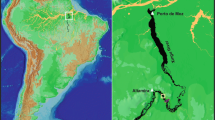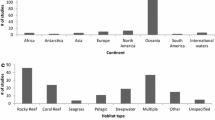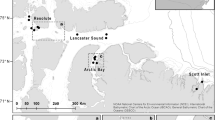Abstract
Methods for the use of baited remote underwater video stations (BRUVS) have been tested and refined such that they are now widely used in marine research for assessing fish community structure. There is comparatively less known about the effectiveness of different bait types or bait containers for use with BRUVS in freshwater temperate environments. We conducted a field-based experiment in Lake Opinicon, located in southeastern Ontario, Canada to compare the effectiveness of three baits and two styles of bait container to unbaited systems. Species richness per deployment and the probability of detecting each species were used as measures of effectiveness. BRUVS were deployed in weedy habitats in the littoral zone of the lake (1–3 m depth) with corn, cat food, sardines, or no bait, in an accessible mesh bag, or an inaccessible perforated PVC container. The mean species richness detected was uniform across bait type and container. For Micropterus salmoides, Cyprinidae spp., and Esox lucius, there were associations between bait type and proportion of detections. BRUVS appear to be effective in observing species richness in a shallow, low-visibility freshwater environment; however, there is little evidence that use of bait improves effectiveness relative to unbaited RUVS.






Similar content being viewed by others
Data availability
The datasets generated during the current study are available from the corresponding author on reasonable request.
Code availability
n/a.
References
Ahrenstorff, T. D., G. G. Sass & M. R. Helmus, 2009. The influence of littoral zone coarse woody habitat on home range size, spatial distribution, and feeding ecology of largemouth bass (Micropterus salmoides). Hydrobiologia 623: 223–233.
Bajaba, S. Z., S. Hugo, A. J. van Wyk, S. M. Marr, N. G. Vine & O. L. F. Weyl, 2021. Can bait improve the efficiency of underwater video monitoring of fish in headwater streams? A case study from the Rondegat River, South Africa. African Journal of Aquatic Science 46: 246–249.
Bassett, D. K. & J. C. Montgomery, 2011. Investigating nocturnal fish populations in situ using baited underwater video: with special reference to their olfactory capabilities. Journal of Experimental Marine Biology and Ecology 409: 194–199.
Cataraqui Region Conservation Authority, 2017. Opinicon Lake Fact Sheets. Glenburnie, ON. [available on internet at https://www.crca.ca/wp-content/uploads/PDFs/LakeReports/2017-FactSheet-OpiniconLake.pdf].
Cousins, S., M. J. Kennard & B. C. Ebner, 2017. Depth-related composition and structuring of tropical riverine fish assemblages revealed by baited video. Marine and Freshwater Research 68: 1965–1975.
Davies-Colley, R. J., W. N. Vant & D. G. Smith, 1994. Colour and Clarity of Natural Waters. Science and Management of Optical Water Quality, Prentice Hall Inc, Englewood Cliffs:
Donaldson, J., P. Drews-Jr, M. Bradley, D. Morgan, R. Baker & B. Ebner, 2019. Countering low visibility in video survey of an estuarine fish assemblage. Pacific Conservation Biology 26: 190.
Dorman, S. R., E. S. Harvey & S. J. Newman, 2012. Bait effects in sampling coral reef fish assemblages with stereo-BRUVs. PLoS ONE 7: e41538.
Ebner, B. C. & D. L. Morgan, 2013. Using remote underwater video to estimate freshwater fish species richness. Journal of Fish Biology 82: 1592–1612.
Ebner, B. C., D. Starrs, D. L. Morgan, C. J. Fulton, J. A. Donaldson, D. J. Sean, S. Cousins, M. Kennard, G. Butler, Z. Tonkin, S. Beatty, B. Broadhurst, R. Clear, M. Lintermans & C. S. Fletcher, 2014. Emergence of field-based underwater video for understanding the ecology of freshwater fishes and crustaceans in Australia. Journal of the Royal Society of Western Australia 97: 287–296.
Ebner, B. C., C. J. Fulton, S. Cousins, J. A. Donaldson, M. J. Kennard, J. O. Meynecke & J. Schaffer, 2015. Filming and snorkelling as visual techniques to survey fauna in difficult to access tropical rainforest streams. Marine and Freshwater Research 66: 120–126.
Ellender B. R., A. Becker & O. L. F. Weyl, 2012. Underwater video analysis as a non-destructive alternative to electrofishing for sampling imperilled headwater stream fishes. Aquatic Conservation: Marine and Freshwater Ecosystems 65: 58–65
Erlandsson, M., I. Buffam, J. Fölster, H. Laudon, J. Temnerud, G. A. Weyhenmeyer & K. Bishop, 2008. Thirty-five years of synchrony in the organic matter concentrations of Swedish rivers explained by variation in flow and sulphate. Global Change Biology 14: 1191–1198.
Flammang, M. K. & R. D. Schultz, 2007. Evaluation of hoop-net size and bait selection for sampling Channel Catfish in Iowa impoundments. North American Journal of Fisheries Management 27: 512–518.
Fulton, C. J., D. Starrs, M. P. Ruibal & B. C. Ebner, 2013. Counting crayfish: active searching and baited cameras trump conventional hoop netting in detecting Euastacus armatus. Endangered Species Research 19: 39–45.
Ghazilou, A., M. R. Shokri & W. Gladstone, 2016. Animal v. plant-based bait: does the bait type affect census of fish assemblages and trophic groups by baited remote underwater video (BRUV) systems? Journal of Fish Biology 88: 1731–1745.
Hannweg, B., S. M. Marr, L. E. Bloy & O. L. F. Weyl, 2020. Using action cameras to estimate the abundance and habitat use of threatened fish in clear headwater streams. African Journal of Aquatic Science 45: 372–377.
Hara, T. J., 1975. Olfaction in fish. Progress in Neurobiology 5: 271–335.
Hartman, K. J., B. Vondracek, D. L. Parrish & K. M. Muth, 1992. Diets of Emerald and Spottail Shiners and potential interactions with other Western Lake Erie planktivorous fishes. Journal of Great Lakes Research Elsevier 18: 43–50.
Harvey, E. S., M. Cappo, J. J. Butler, N. Hall & G. A. Kendrick, 2007. Bait attraction affects the performance of remote underwater video stations in assessment of demersal fish community structure. Marine Ecology Progress Series 350: 245–254.
Harvey, E. S., D. L. McLean, S. Frusher, M. D. E. Haywood, S. J. Newman & A. Williams, 2013. The use of Bruvs as a tool for assessing marine fisheries and ecosystems: A review of the hurdles and potential. Fisheries Research and Development Corporation, and the University of Western Australia, Crawley, Australia.
Helfman, G. S., 1981. The advantage to fishes of hovering in shade. American Society of Ichthyologists and Herpetologists 1981: 392–400.
Holm, S., 1978. A simple sequentially rejective multiple test procedure. Scandinavian Journal of Statistics 6: 65–70.
Jamieson, A. J., D. M. Bailey, H. Wagner, P. M. Bagley & I. G. Priede, 2006. Behavioural responses to structures on the seafloor by the deep-sea fish Coryphaenoides armatus: implications for the use of baited landers. Deep Sea Research Part i: Oceanographic Research Papers 53: 1157–1166.
Jones, R. E., R. A. Griffin, S. R. Januchowski-Hartley & R. K. F. Unsworth, 2020. The influence of bait on remote underwater video observations in shallow-water coastal environments associated with the North-Eastern Atlantic. PeerJ 8: 1–21.
Keast, A. & J. Harker, 1977. Fish distribution and benthic invertebrate biomass relative to depth in an Ontario lake. Environmental Biology of Fishes 2: 235–240.
Keast, A., J. Harker & D. Turnbull, 1978. Nearshore fish habitat utilization and species associations in Lake Opinicon (Ontario, Canada). Environmental Biology of Fishes 3: 173–184.
Kim, H. Y., 2013. Statistical notes for clinical researchers: assessing normal distribution (2) using skewness and kurtosis. Restorative Dentistry & Endodontics Korean Academy of Conservative Dentistry 38: 52–54.
King, A. J., A. George, D. J. Buckle, P. A. Novak & C. J. Fulton, 2018. Efficacy of remote underwater video cameras for monitoring tropical wetland fishes. Hydrobiologia 807: 145–164.
Kirk, J. T. O., 1994. Light and Photosynthesis in Aquatic Ecosystems, Cambridge University Press, Cambridge:
Lyle, J. M., D. M. Furlani & C. D. Buxton, 2007. Cutting-edge technologies in fish and fisheries science. Australian Society for Fish Biology Workshop Proceedings. Hobart, Tasmania 2007: 101–114.
Maine, P. I. N., J. R. Moring & P. H. Nicholson, 1994. Evaluation of three types of artificial habitats for fishes in a freshwater pond in Maine, USA. Bulletin of Marine Science 55: 1149–1159.
Mallet, D. & D. Pelletier, 2014. Underwater video techniques for observing coastal marine biodiversity: a review of sixty years of publications (1952–2012). Fisheries Research 154: 44–62.
McDonald, J. H., 2014. Handbook of Biological Statistics, Sparky House Publishing, Baltimore:
Olmsted, J. M. D., 1918. Experiments on the nature of the sense of smell in the common catfish, Amiurus Nebulosus (Leseur). American Journal of Physiology 46: 443–455.
Pelletier, D., K. Leleu, G. Mou-Tham, N. Guillemot & P. Chabanet, 2011. Comparison of visual census and high definition video transects for monitoring coral reef fish assemblages. Fisheries Research 107: 84–93.
Pierce, R. B., D. W. Coble & S. Corley, 1981. Fish catches in baited and unbaited hoop nets in the Upper Mississippi River. North American Journal of Fisheries Management 1: 204–206.
R Core Team 2020. R: A language and environment for statistical computing. R Foundation for Statistical Computing, Vienna, Austria. https://www.R-project.org/.
Roberts, M. E., B. M. Burr, M. R. Whiles & V. J. Santucci, 2006. Reproductive ecology and food habits of the blacknose shiner, Notropis heterolepis, in Northern Illinois. American Midland Naturalist 155: 70–83.
Sass, G. G., S. R. Carpenter, J. W. Gaeta, J. F. Kitchell & T. D. Ahrenstorff, 2012. Whole-lake addition of coarse woody habitat: response of fish populations. Aquatic Sciences 74: 255–266.
Schmid, K., J. A. Reis-Filho, E. Harvey & T. Giarrizzo, 2017. Baited remote underwater video as a promising nondestructive tool to assess fish assemblages in clearwater Amazonian rivers: testing the effect of bait and habitat type. Hydrobiologia 784: 93–109.
Stobart, B., J. A. García-Charton, C. Espejo, E. Rochel, R. Goñi, O. Reñones, A. Herrero, R. Crech’riou, S. Polti, C. Marcos, S. Planes & A. Pérez-Ruzafa, 2007. A baited underwater video technique to assess shallow-water Mediterranean fish assemblages: methodological evaluation. Journal of Experimental Marine Biology and Ecology 345: 158–174.
Struthers, D. P., A. J. Danylchuk, A. D. M. Wilson & S. J. Cooke, 2015. Action cameras: bringing aquatic and fisheries research into view. Fisheries 40: 502–512.
Watson, D. L., E. S. Harvey, M. J. Anderson & G. A. Kendrick, 2005. A comparison of temperate reef fish assemblages recorded by three underwater stereo-video techniques. Marine Biology 148: 415–425.
Whitmarsh, S. K., P. G. Fairweather & C. Huveneers, 2017. What is big BRUVver up to? Methods and uses of baited underwater video. Reviews in Fish Biology and Fisheries 27: 53–73.
Willis T. J., R. B. Millar & R. C. Babcock, 2000 Detection of spatial variability in relative density of fishes: comparison of visual census, angling, and baited underwater video. Marine Ecology Progress Series 198: 249–260
Wilson, K. L., M. S. Allen, R. N. M. Ahrens & M. D. Netherland, 2014. Use of underwater video to assess freshwater fish populations in dense submersed aquatic vegetation. Marine and Freshwater Research 66: 10–22.
Wraith, J., T. Lynch, T. E. Minchinton, A. Broad & A. R. Davis, 2013. Bait type affects fish assemblages and feeding guilds observed at baited remote underwater video stations. Marine Ecology Progress Series 477: 189–199.
Acknowledgements
Thanks to the staff of the Queen’s University Biological Station for their support. Benjamin Hlina provided input on statistical analysis. Brooke Etherington and Daniel Mameri assisted with data collection.
Funding
Funding was provided by an NSERC Strategic Grant to Dr. Cooke, Dr. Bennett, and Dr. Vermaire in partnership with Parks Canada. Dr. Cooke, Dr. Bennett, and Dr. Vermaire are further supported by NSERC Discovery Grants.
Author information
Authors and Affiliations
Contributions
n/a.
Corresponding author
Ethics declarations
Conflict of interest
The authors have no conflicts of interest to disclose.
Additional information
Handling editor: Michael Power
Publisher's Note
Springer Nature remains neutral with regard to jurisdictional claims in published maps and institutional affiliations.
Rights and permissions
About this article
Cite this article
Glassman, D.M., Chhor, A., Vermaire, J.C. et al. Does bait type and bait container configuration influence the performance of remote underwater video systems in temperate freshwater lakes for assessing fish community structure?. Hydrobiologia 849, 1981–1994 (2022). https://doi.org/10.1007/s10750-021-04776-7
Received:
Revised:
Accepted:
Published:
Issue Date:
DOI: https://doi.org/10.1007/s10750-021-04776-7




